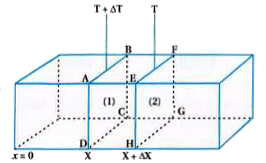Discuss the factors on which amount of thermal energy passing perpendicularly between two nearby cross-section depends. Hence obtain expression for heat current. Solution in Gujrati
Figure shows a rectangular block of solid of cross section .A..

Let us consider two cross sections ABCD and EFGH, at a distance x and Δx from one end of a block having temperature T+ΔT and T respectively.
Here, the distance between two cross section is Δx and temperature difference is ΔT.
The ratio ΔT/Δx is called temperature gradient
Temperature gradient : The difference in temperature per unit distance between two parts of a solid is called distance between two parts of a solid is called as temperature gradient parts of a solid is called as temperature gradient. Its unit is Kelvin/meter and dimensional formula is M0L−1T0K1.
Experiment shown that for a small change in temperature, the amount of heat passing between these two cross sectional planes in direction perpendicular to these planes in time Δt depends on the following factors :
ΔQ∝ΔTΔx (For given Δt and A)
ΔQ∝Δt (For given ΔT/Δx and A)
ΔQ∝A For given Δt and ΔT/Δx)
∴ΔQ=−kAΔTΔxΔt
ΔQΔt=−kAΔTΔx . . .(1)
Here, k is constant of proportionality called thermal conductivity of the material of the block. Its value depends on the type of the material and to some extent on the temperature.
The materials with higher value of thermal consuctivity are good conductors of heat.
Normalally, if the differnces in the temperatures of different parts of solid are not very large, k can be considered a constant.
Negative sign in above equation indicates that with the increase in x the temperature decreases.
Taking limits Δx→0 and Δt→0 in equation (1)
dQdt=−kAdTdx . . . (2)
∴H=−kadQdt
dQdt=H is called heat current. Heat current is the rate of flow of heat through any cross section.
Its unit is cal/s or J/s, its dimensional formula is M1L2T−3.
Topper's Solved these Questions
- BOOK - KUMAR PRAKASHANCHAPTER - THERMAL PROPERTIES OF MATTEREXERCISE - Section - B (Numericals) Numerical From Textual Illustration8videos
THERMAL PROPERTIES OF MATTER
- BOOK - KUMAR PRAKASHANCHAPTER - THERMAL PROPERTIES OF MATTEREXERCISE - Section - B10videos
THERMAL PROPERTIES OF MATTER
- BOOK - KUMAR PRAKASHANCHAPTER - THERMAL PROPERTIES OF MATTEREXERCISE - Try Yourself (VSQs)84videos
THERMAL PROPERTIES OF MATTER
- BOOK - KUMAR PRAKASHANCHAPTER - SYSTEMS OF PARTICLES AND ROTATIONAL MOTIONEXERCISE - SECTION-F (SECTION-D) QUESTIONS PAPER1videos
SYSTEMS OF PARTICLES AND ROTATIONAL MOTION
- BOOK - KUMAR PRAKASHANCHAPTER - THERMODYANMICS EXERCISE - Question Paper11videos
THERMODYANMICS
Similar Questions
Show that the coefficient of area expansions, (ΔA/A)/ΔT, of a rectangular sheet of the solid is twice its linear expansively, αl.(αl=10−5K−1)
03:46View SolutionShow that the coefficient of area expansions, (ΔA/A)/ΔT, of a rectangular sheet of the solid is twice its linear expansively, αl.(αl=10−5K−1)
03:38View Solution''Amount of heat is greater in hot body than cold body''. Check correctness of this statement.
06:10View SolutionA rope of negligible mass is wound round a hollow cylinder of mass 3 kg and radius 40 cm. What is the angular acceleration of the cylinder if the rope is pulled with a force of 30 N? What is the linear acceleration of the rope? Assume that there is no slipping.
10:04View SolutionWhy is a steam burn more damaging than a burn with boiling water of the same ?
10:04View SolutionA current passes through a wire of nonuniform cross-section. Which of the following quantites are independent of the cross section?
08:36View SolutionObtain the expression for the magnetic energy stored in an ideal inductor of self inductance L when a current I passes through it.
Hence obtain the expression for the energy density of magentic field produced in the inductor.04:12View Solutionपलायन वेग की परिभाषा दीजिये | इसके लिए एक व्यंजक प्राप्त कीजिए तथा विवेचना कीजिए कि यह किन कारको पर निर्भर करता है ?
08:38View SolutionObtain an expression for the force between two straight parallel conductor carrying current. Hence define ampere.
01:30View SolutionObtain an expression for the force between two straight parallel conductors carrying current. Hence define ampere.
06:29View SolutionHeat produced in a current carrying conducting wire depends on current I, resistance R of the wire and time t for which current is passed. Using these facts, obtain the formula for heat energy
View SolutionWhat is heat of a reaction? Discuss the factors on which it is dependent.
00:58View SolutionObtain the expression for the magnetic energy stored in an ideal inductor of self inductance L when a current I passes through it. Hence obtain the expression for the energy density of magentic field produced in the inductor.
08:45View SolutionA current passes through a wire of nonuniform cross-section. Which of the following quantites are independent of the cross section?
02:06View SolutionState the factors on which the conduction of heat through a substance depends. Obtain an expression for the heat conducted and hence define coefficient of thermal conductivity and give its units and dimensions.
01:56View Solution

